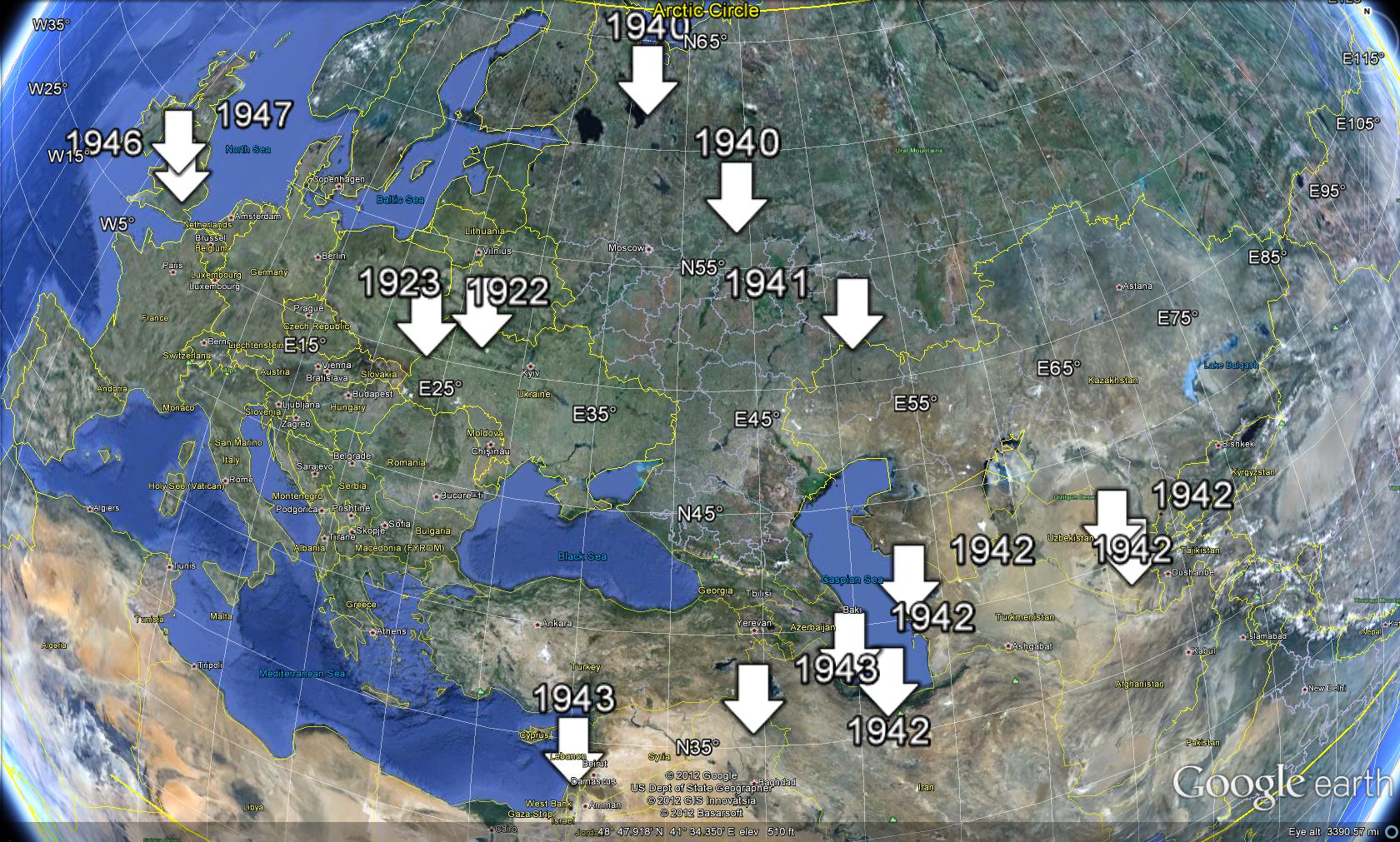|
1939 World
War II began with German invasion on Poland on September 1st; USSR
invaded Poland on September 17th.
1940
Soviets
began mass deportations of people from Polish territories (mostly
Poles) to Siberia, to forced labor camps of Gulag.
- February -- 1st deportation
- April -- 2nd deportation
- June -- 3rd deportation
1941
June
-- 4th deportation of people from Polish territories to Siberia.
August 14th -- Soviet-Polish military agreement
(signed as a consequence of the July 30 treaty) -- based on which a
Polish army could be formed in the Soviet Union from former Polish
Gulag prisoners, under the command of general
Wladyslaw Anders.
September
-- Gen. Anders’ Army began forming itself in the Soviet Union territory.
Gen. Wladyslaw Anders wrote
in memoir:
“The Soviet authorities
were surprised by the huge number of Poles reporting for military
service. They probably thought that few would get out of concentration
camps alive, and that none of them would be fit for active service. I
had an opportunity to talk to thousands of men, women and children who
arrived in the camp, and to my horror they fully corroborated all I had
heard about the terrible treatment the Poles had received at the hands
of the Soviet authorities. (…)
I could only form a full and detailed picture of these horrors when,
with the gradual organization of the Polish army, I saw arriving from
all parts of the boundless Russian territory a flood of thousands and
dozens of thousands of prisoners of war and imprisoned or deported
civilians, who told of their experiences and of the fate of their
families and friends. They were but a small proportion of the people
deported to Russia, which amounted to over a million.
Until then each one had known only his
own story or those of his fellow-prisoners, but when they came
together in the army it became clear to us how the Russians had
systematically drained from Poland all people of value to the nation,
whatever their racial origin, class or religion: Poles and Ukrainians,
While Ruthenians, Lithuanians and Jews, landowners and farm-hands,
factory owners and workers, officers and other ranks, judges, tradesmen
and policemen, Roman Catholic priests and Protestant ministers and
Rabbis, all were torn away from their homes, absorbed by the monstrous
machine of the N.K.V.D., and sent to Soviet prisons and camps.”
Wladyslaw Anders, An Army on Exile, pp. 65-66
1942
January
--
- a new center of organization
of the Polish Army was established in Guzar (Uzbekistan).
- The sanitary situation in the
camp in Guzor was tragic. Epidemic diseases were spreading. One of the soldiers recalls:
“W Guzarze szerzyla sie
epidemia czerwonki i tyfusu. Codziennie umierali zolnierze, a
szczegolnie osoby cywilne, ktore przybyly z wojskiem. Napredce
zorganizowalismy posilki, bylismy stale glodni, zawsze dlugo czekalismy
na chleb, a po otrzymaniu go z miejsca porcje dzienna zjadalismy aby
zaspokoic glod. (…) Pewnego dnia, jako dowodca warty mieszczacej sie w
budynku, ktory gorowal nad droga, powolywalem warte pod bron, by oddac
honory zmarlym zolnierzom wywozonych na wojkowych furmankach calymi
dzisiatkami na cmentarz. W tym dniu robilem to kilka razy co
swiadczylo, ze w Guzarze jest zle.”
Piotr Zaron, Armia Andersa,
p. 99
TRANSLATION:
"In Guzar epidemic
diseases were spreading. Soldiers, and especially civilians who
traveled with the army, were dying everyday. We organized meals
hastily, we were hungry all the time, we always waited for bread so
long, and, after receiving it, we were eating the daily portion at once
to satisfy the hunger. (...) One day, as a commander of the guard
located in a building that was above a road, I was calling guard to
arms in order to honor the dead soldiers carried on carts to the
cemetery. That day I was doing that several times, what meant that the
situation in Guzar was bad."
January
17th--
Gen. Szysko-Bohusz
reported:
“Z tym wszystkim co
stanowilo zalazek 7 Dywizji Piechoty wyjechalem 17 stycznia do Kermine.
Nasze wagony byly wlaczone do bardzo dlugiego pociagu towarowego, ktory
szedl do Krasnowodzka i godzinami stal na malenkich stacyjkach w
szczerej pustyni.”
Gen. Szyszko-Bohusz, report, cyt za: Piotr Zaron, Armia Andersa,
p.99
TRANSLATION:
"With all that
constituted the seeds of the 7th Infantry Division I traveled on
January 17th to Kermine. Our trains were attached to a very long goods
train which went to Krasnowodzk and stayed hours on the small stations
in the desert along the way."
March
- August-- Evacuation of the Polish Army from centers of
organization in Uzbekistan to Iran (through Krasnowodzk
to Pahlavi)
- Gen. Wladyslaw Anders wrote about the evacuation:
“The talk lasted from
half-past three in the afternoon until seven o’clock. It touched on all
manner of subjects, Stalin sometimes, in his strange way, breaking
suddenly in the middle of a sentence to refer to an entirely irrelevant
matter. It surprised me that Stalin had so readily agreed to my
suggestions. They involved such important decisions for the Soviet
Union that I could only attribute their readiness to meet us to the
difficulties Russia was experiencing at the front. (…) Not only did
Russians take these decisions quickly, but they promptly and
energetically took action to organize transport for those to be
evacuated. (…) The convoys were to go by rail to Krasnovodsk, and from
there by boat to Pahlevi.”
Wladyslaw Anders, An Army on Exile, p 100
“Pierwszy transport
ewakuacyjny doroga morska odplynal z Krasnowodzka do Pahlavi juz 24
marca i doplynal do celu w dniu nastepnym. Od tego dnia do 5 kwietnia
trwala pierwsza ewakuacja zolnierzy polskich i rodzin wojskowych z
terytorium ZSRR (…) Ogolem zostalo ewakuowanych 43 858 osob, w tym 1603
oficerow, 28 427 podoficerow I szeregowych, 1159 ochotniczek, 1880
junakow i 10 789 osob cywilnych, w tym 3100 dzieci. Wladze radzieckie
podstawily do ewakuacji 34 pociagi ewakuacyjne I 17 statkow morkich.”
Piotr Zaron, Armia Andersa, p. 119
TRANSLATION:
"The
first transport of evacuation sailed from Krasnowodzk to Pahlavi
already on March 24th and got to the destination the next day. From
that day until April 5th the first evacuation of the Polish soldiers
and their families from the Soviet Union territory took place. (...) In general 43
858 people had been evacuated, including: 1603 officers, 28 427
non-commissioned officers and serial soldiers, 1159 volunteers, 1880
cadets and 10 789 civilians including 3100 children. Soviet authorities
allocated 34 trains and 17 ships."
II. August 9 - 30th 1942:
“Wczasie trwania ewakuacji temperatura w
ciagu dnia dochodzila do 60 C w sloncu. Rejs statku przez Morze
Kaspijskie trwal przecietnie okolo trzydziestu godzin. W okresie
dwudziestu dwoch dni sierpnia ewakuowano z ZSRR do Iranu 69 247 osob, w
tym 2430 oficerow, 36 701 podoficerow i szeregowcow, 112 urzedniokow
wojskowych, 1765 ochotniczek I siostr PCK, 2738 junakow i junaczek oraz
25 501 osob cywilnych, wsrod nich 9633 dzieci”
Piotr Zaron, Armia Andersa, p. 141
TRANSLATION:
"During the evacuation
the temperature was reaching 60 C in sun. The cruise of the ship
through the Caspian Sea lasted typically 30 hours. In the time period
of twenty two days of August 69 247 people had been evacuated from USSR
to Iran, including 2430 officers, 36 701 non-commissioned officers and
serial soldiers, 112 military clerks, 1765 volunteers and the Red Cross
sisters, 2738 cadets and 25 501 civilians including 9633 children"
- Over 10 000 civilians traveling with the army died along
the way and were buried in SRRs and Iran. There are 13 Polish
cemeteries in Uzbekistan, one in Guzar, and one in Kermine (Navoi).
This is most likely where Jan, Stanislaw and Janka were buried. However
most of the Poles buried there are not identified.
- Also,
as Piotr Zaron writes:
"ewakuowana z ZSRR ludnosc cywilna zostala
czasowo rozmieszczona w Teheranie, a nastepnie przewieziona do Indii i
do niektorych krajow afrykanskich, m. in. do Kenii, Ugandy, Tanzanii."
Piotr
Zaron, Armia Andersa, p. 169
TRANSLATION:
"civilians evacuated
from USRR had been temporarily located in Teheran, and then transported
to India and some of the African countries, among others to Kenia,
Uganda, Tanzania"
September
-- Evacuation from Pahlavi to Teheran
Gen. Wladyslaw Anders
wrote:
“As soon as I had got back to Teheran I
had to take most energetic action to organize camps for the civilian
evacuees who were being brought from Pahlevi to Teheran, and to
establish hospitals for them, for even after their arrival at Teheran
the effects of their past privations were so great that many died, and
within a few weeks there were over a thousand crosses in the Polish
cemetery.”
Wladyslaw Anders, An Army on Exile, pp. 127-8
1943
July--The formation of Polish II Corps
was completed in Iraq, in Kirkuk
region.
- Antoni Kowalski was a soldier in the Anders Army; he
joined the Polish II Corps, which was forming itself in the northern
Iraq since August 1942. Soldiers traveled to Iraq from Palestine (where
the part of them already stationed) or directly from Pahlavi (in August/September 1942).
August -
September
- Polish II Corps was relocated to Palestine and the army
went there through a training, which was impossible in the desert
environment of Iraq.
Antoni was allowed to travel to
Nazareth two weeks earlier, together with Zosia and with the part of
the staff of army’s base.
December
--
- Polish II
Corps was transported to Italy where,
under British command, fought in the Italian Campaign.
1944
February -- General Anders
joined them in February 1944.
He wrote
in his memoir:
“On February 6, 1944, I flew to Italy, and
I and all the Army Corps felt that the eyes of Poles all over the
world, and, above all, of those at home, were upon us.”
Wladyslaw Anders, An Army on Exile, p. 153
1945
1946 Anders' Army began relocation form Italy and
Palestine to Great Britain.
|

